Complementary colors sit directly opposite each other on the color wheel — red and green, purple and yellow, and blue and orange. When paired in a planting design, complementary colors just feel right. Here’s a sampling of container garden designs that use complementary colors with dazzling success.
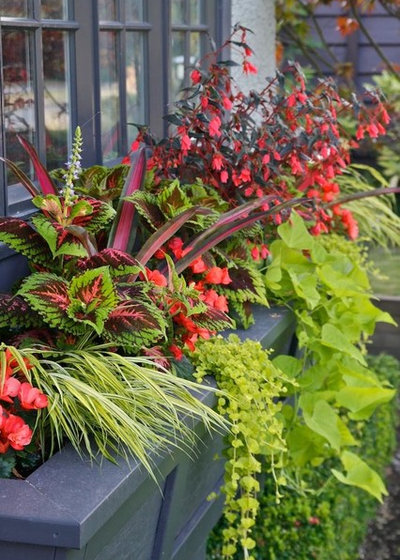
Pot Incorporated
Red and Green
Red is considered a warm color, but its vibrancy is greatly affected by whether it has orange or blue undertones. In this example, the reds have orange undertones, and when paired with chartreuse, they give the arrangement a lively, tropical feel. Believe it or not, this window box is in Vancouver, Canada.
Plant combo (click each photo to see the plants tagged)
:- Golden Japanese forest grass (Hakonechloa macra ‘Aureola’, USDA zones 4 to 9; find your zone)
- ‘Marguerite’ sweetpotato vine (Ipomoea batatas ‘Marguerite’, zones 9 to 11)
- ‘Bellfire’ begonia (Begonia boliviensis ‘Bellfire’, zones 9 to 11)
- ‘Solenia Orange’ begonia (Begonia ‘Solenia Orange’, zones 9 to 11)
- Golden creeping jenny (Lysimachia nummularia ‘Aurea’, zones 3 to 9)
- ‘Kong Salmon Pink’ coleus (Solenostemon scutellarioides ‘Kong Salmon Pink’, zones 10 to 11)
Light requirement: Partial sun to shade
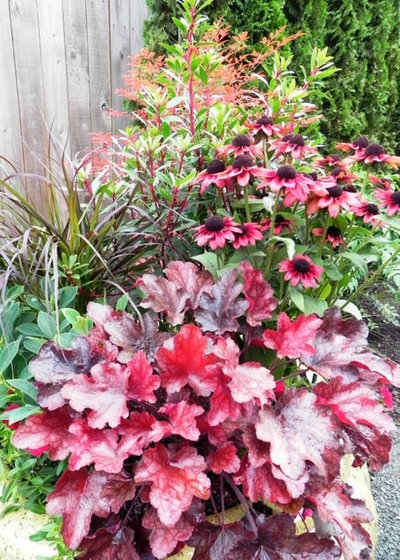
Sublime Garden Design, LLC
A “cool” red is one that has blue undertones. The reds in this arrangement are more of a burgundy or brick red. While still eye-catching, this container planting has less contrast between the reds and greens and is therefore more subtle
.Plant combo:- Purple fountain grass (Pennisetum setaceum ‘Rubrum’, zones 8 to 11)
- ‘Moyer’s Red’ heavenly bamboo (Nandina domestica ‘Moyer’s Red’, zones 6 to 9)
- Mountain pepper (Drimys lanceolata, zones 8 to 10)
- ‘Cherry Brandy’ blackeyed Susan (Rudbeckia hirta ‘Cherry Brandy’, zones 3 to 9)
- ‘Berry Marmalade’ coral bells (Heuchera ‘Berry Marmalade’, zones 4 to 9)
Light requirement: Partial sun
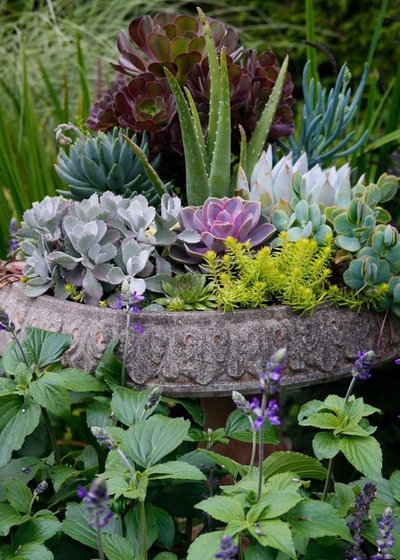
Pot Incorporated
Purple and Yellow
Purple and yellow are common flower colors — bees and birds are instantly attracted to them.
Here’s an arrangement that features purple and yellow but is more about foliage texture and shape than flowers.
The dusty purple hues found in the echeveria and salvia are balanced by the golden yellow of the Angelina stonecrop and string of pearls plant.
Plant combo:- ‘Angelina’ stonecrop (Sedum rupestre ‘Angelina’, zones 3 to 8)
- ‘Perle von Nürnberg’ echeveria (Echeveria ‘Perle von Nürnberg’, zones 9 to 11)
- Aloe vera (Aloe vera, zones 6 to 9)
- ‘Mexican Giant’ echeveria (Echeveria colorata ‘Mexican Giant’, zones 9 to 11)
- Blue chalk sticks (Senecio serpens, zones 9 to 12)
- ‘Velour’ Aeonium (Aeonium ‘Velour’, zones 9 to 11)
Light requirement: Full sun
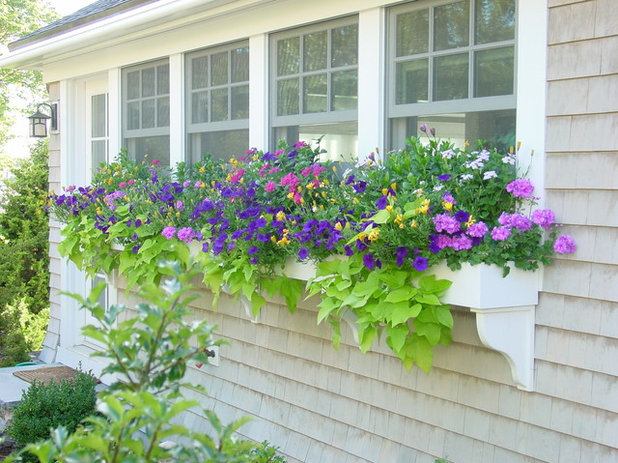
Michelle Jacoby, Changing Spaces
There’s no denying a burst of color from flowers is intoxicating. Imagine having this lovely arrangement right outside your window. The golden foliage of ‘Marguerite’ sweetpotato vine contrasts with purple petunias and geraniums. Bright yellow African daises
are just beginning to pop, adding an extra jolt of color.
Plant combo- Sweetpotato vine (Ipomoea batatas cv., zones 8b to 11)
- Geranium (Pelargonium sp.)
- Periwinkle (Vinca sp.)
- Lobelia (Lobelia sp.)
- Supertunia petunia (Petunia hybrid)
Light requirement: Partial sun
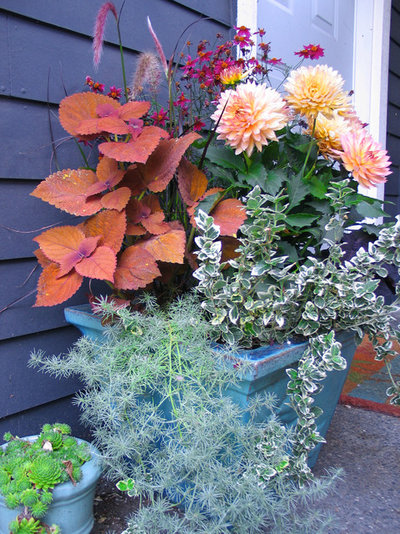
Exteriorscapes llc
Blue and Orange
The pairing of blue and orange has a crispness to it. It’s bright without being loud — soothing and warm at the same time.
Plant combo:- Parrot’s beak (Lotus maculatus, zones 9 to 11)
- ‘Sedona’ coleus (Solenostemon scutellarioides ‘Sedona’, zones 10 to 11)
- Dahlia (Dahlia sp., zones 8 to 10)
- Tickseed (Coreopsis sp.)
- Japanese spindletree (Euonymus japonicus, zones 6 to 9)
- Fountain grass (Pennisetum setaceum, zones 9 to 11)
Light requirement: Sun to partial sun
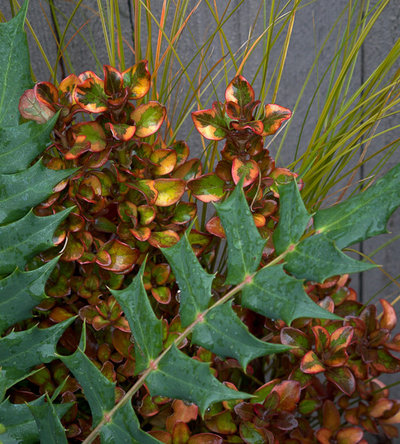
Personal Garden Coach
Plants with blue-green foliage have a tendency to recede into the background, almost as if they’re shy. Orange is their extroverted friend that helps bring them to the forefront. Here, low
Oregon grape pops against the bright orange foliage of ‘Tequila Sunrise’ coprosma and orange sedge.
Plant combo
- ‘Charity’ Oregon Grape (Mahonia x media ‘Charity’, zones 7 to 9)
- Orange sedge (Carex testacea, zones 7 to 10)
- Mirror plant (Coprosma repens cv., zones 8 to 11)
Light requirement: Sun to partial sun
Watering requirements: The location and the time of year make all the difference when it comes to watering your pots. Depending on where you live and if it rains a lot during the winter, you may not have to water your container garden at all (unless it’s located under eaves). However, if you have a south-facing pot that receives full sun during the summer, you may have to water your pots several times a week.
Because of the limited soil volume, container plantings tend to dry out more quickly than plants in the ground. A good rule of thumb is to stick your finger into the soil. If the top 1 to 2 inches is dry, it’s time to water. Water until the water begins to trickle out the hole in the bottom of the pot to make sure it’s received a thorough soaking.
How and When to Water Potted Plants
Show us your colorful containers: These examples are just the tip of the iceberg — share photos of your plant combinations in the Comments.





